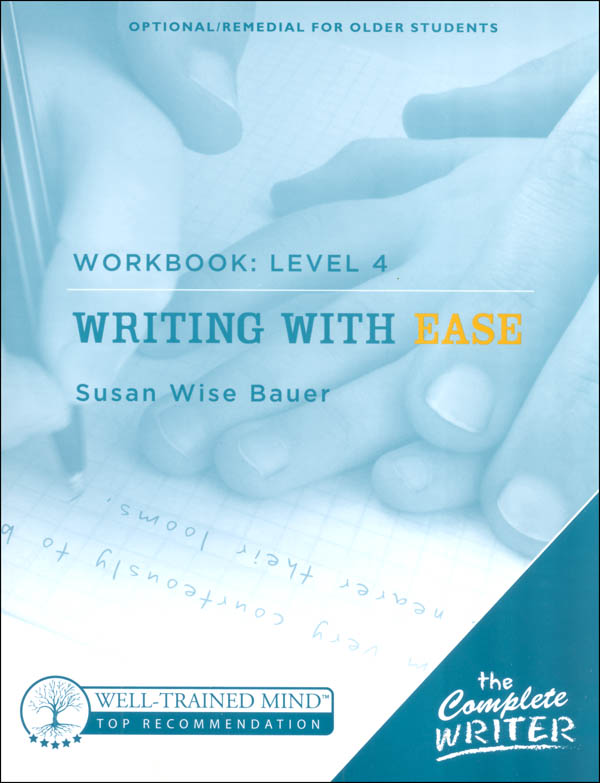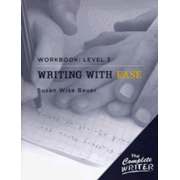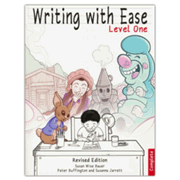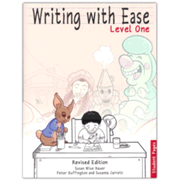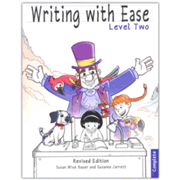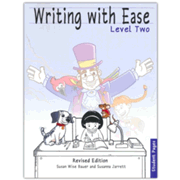The Complete Writer: Writing With Ease (WWE) is a narrowly-focused program that does not easily compare with others. It seems to serve as a supplement rather than a core program, but it is scheduled to be used four days per week for 36 weeks. (The revised editions of Level One and Level Two add an optional creative writing exercise for day 5.) At this time there are four levels, targeting students in grades one through four or older students who have not yet developed the skills covered in each level.
While WWE encompasses some grammar instruction, it is by no means a comprehensive grammar program. Grammar will be picked up incidentally simply by exposure to good writing, copywork, and all of the writing practice. Grammar is occasionally taught directly for punctuation and capitalization, and it is sometimes mentioned in brief discussions about usage and syntax. The assumption is that students are learning grammar through another program, and WWE will reinforce that.
Neither is WWE a composition course, although students will develop some composition skills through interaction with the literary passages and the writing and copywork they do. It should work best as a supplemental course for classical educators. Reading comprehension, developing narration and summary skills, and copywork comprise the bulk of this program.
The publisher responded to the above comments with this clarification:
The authors have intended Writing With Ease to be one component of a complete language arts program that includes grammar, spelling, writing and reading. We recommend our grammar program, First Language Lessons (FLL), to go along with WWE, but WWE will work well with other grammar programs also. FLL reinforces what is taught in WWE and WWE reinforces what is taught in FLL. The authors of The Well-Trained Mind believe that too many language arts programs put grammar and writing together in the same book requiring too much writing for the young student. For this reason, our materials divide grammar and writing up so that the student can progress in each subject at his/her own pace.
There are a few options for using Writing With Ease. Those who are more ambitious and want to use their own selected content for lessons can purchase The Complete Writer: Writing With Ease Instructor Text that explains the methodology with examples covering grades 1 through 12, then create their own lessons. However, the Instructor Text is really intended to provide support for parents when they run into questions/concerns while teaching writing to their students through the workbooks. The Instructor Text is the trouble-shooting and reference source. The publisher points out that Part I “Understanding the Process” and the appendices are particularly important to all parents using this program.
Most parents will prefer the workbooks for each level that have fully developed, step-by-step, scripted lesson plans that include literary passages. The first part of the workbook is the Instructor Section, and the second part is Student Pages. If you have more than one student working through the same lessons, you can purchase Student Pages for each additional student. Both workbooks and Student Pages are available either in print or as PDFs. (PDFs are available only directly from the publisher.)
I reviewed the workbook for each level. One or two passages from classic literature (including poetry) or non-fiction books, such as Hillyer's A Child's Geography of the World, are used each week. Literary passages for the first two levels have been included in the Instructor Section of the book and are to be read aloud to children. In Levels Three and Four, the passages appear in the student pages for them to read themselves either silently or aloud. Thus, the number of student pages in proportion to instructor pages changes significantly with Level Three.
Narration exercises are used throughout this curriculum, but it is important to recognize that there are different forms of narration. Catherine Levison, author of A Charlotte Mason Education tells us that
Narration is an easy, normal and effective way to retain information. We have all used this process when we've told someone about a meeting we have attended, a documentary we've seen, or a book we have read. That is why it is also called "telling back." The act of repeating information or events has a powerful effect on memory, much like when we repeat a number over and over to ourselves if we are unable to write it down. It's different from summarizing information because we allow the person narrating to choose the emphasis, even the omissions, and in all ways we let his or her mind act on the material. (From http://www.charlottemasoneducation.com/narration.html)
This highlights both the benefit of narration and a key difference between the Charlotte Mason approach to narration and the method used in Writing With Ease and some other classically-oriented programs. Both educational approaches value narration as a tool to reinforce memory and recall. However, Charlotte Mason would have the child select his or her emphases and important facts. WWE is much more prescriptive in narration activities (with the exception of Level One), asking students to retell specific information rather than selectively recalling it; it functions more like oral quizzing than a natural narration. In WWE, there is a focus to the questions, and this becomes especially clear in Level Two: the questions are designed to help the child identify key elements of the story so that they will be able to accurately summarize it. So narration in WWE works to develop mental discipline, listening and reading skills, memorization, and oral presentation in a logical fashion, but it is not the same as the narration technique recommended by Charlotte Mason, which would give the child much more control. This distinction becomes clearer in Level Two and above.
In a typical lesson in Level One, after the instructor has read a passage to the child, the instructor works through a series of questions orally with the child to help them recall content and analyze what took place. Next, the instructor asks the child, “ What is one thing you remember about the passage?” The instructor records the student's answer on the appropriate student page. Sometimes the student is directed to use that passage for copywork, while other lessons provide copywork drawn from the literary selections. Copywork passages all appear on student pages, accompanied by blank lines for their work. Delightful illustrations appear on about half of the pages. Level One stresses that students are to respond in complete sentences.
Level Two introduces dictation. Prior to dictation, the instructor might alert the student to watch for unusual punctuation or situations where it might not be obvious how the passage should be punctuated. This is very helpful. Some other programs seem to expect students to know which of a number of possible methods of punctuation they should choose without any guidance. Level Two also asks students to identify central details or to summarize the central narrative thread in a passage rather than simply narrating “one thing you remember.”
Students in Levels Three and Four will read passages on their own, but the instructor might want to have them read these passages aloud for the benefit of both student and instructor. The instructor needs to be familiar with the passage to be able to help the student with their narration, and the discussion should happen immediately after the child has heard or read the passage.
In Level Three, after students read passages independently, the instructor follows immediately with the “oral questioning” described above. The instructor records (writes) the student's summary or narration. Sometimes the instructor will select portions of the student's own narration to give to the student through dictation, but other passages are also used for dictation.
Level Four continues to work like Level Three but with lengthier reading and dictation passages; dictation passages might consist of a number of sentences. The instructor is supposed to repeat the passage only three times and students are to repeat it back before writing. This might be very difficult for a child who is not a strong auditory learner. Consider that the student must think about spelling and punctuation while recalling the passage. The instructor is told to watch students as they write and correct them as they might begin to make a mistake.
Throughout this program, instructors also have to take dictation. Students recite the one thing they remember (in level one), narrative summary, or details in response to the literary passage. The instructor is to write down the student's narration. Beginning in Level Three, the student is asked to recall what they said (likely with the assistance of some prompting) and write it down for themselves.
An evaluation at the end of each level should be used to determine whether or not a student is ready to move to the next level. If not, you can create more exercises of the same type using whatever literature you choose. You should have become so familiar with the type of questions to ask by that point that it should be relatively easy to do this. You might even find that after using a level, you feel able to work the next year without a workbook. Personally, I think following these lesson plans for a few years might start to seem redundant and boring. Some children will pick up the ideas quickly and learn to read, think, and write with discernment without having to work through the oral questions/narration so frequently. So I might use one of these books on a more stretched-out schedule than is suggested—maybe every other week.
Summary
Writing With Ease is an intensive one-on-one program. While no preparation time is required for lessons if you purchase the workbooks, the instructor will interact with the student much of the time. A significant number of sample pages from each book can be viewed for free on the publisher's website, so you can try it out before purchasing.
Note: The Writing With Skill series continues The Complete Writer program for grades five through eight.











